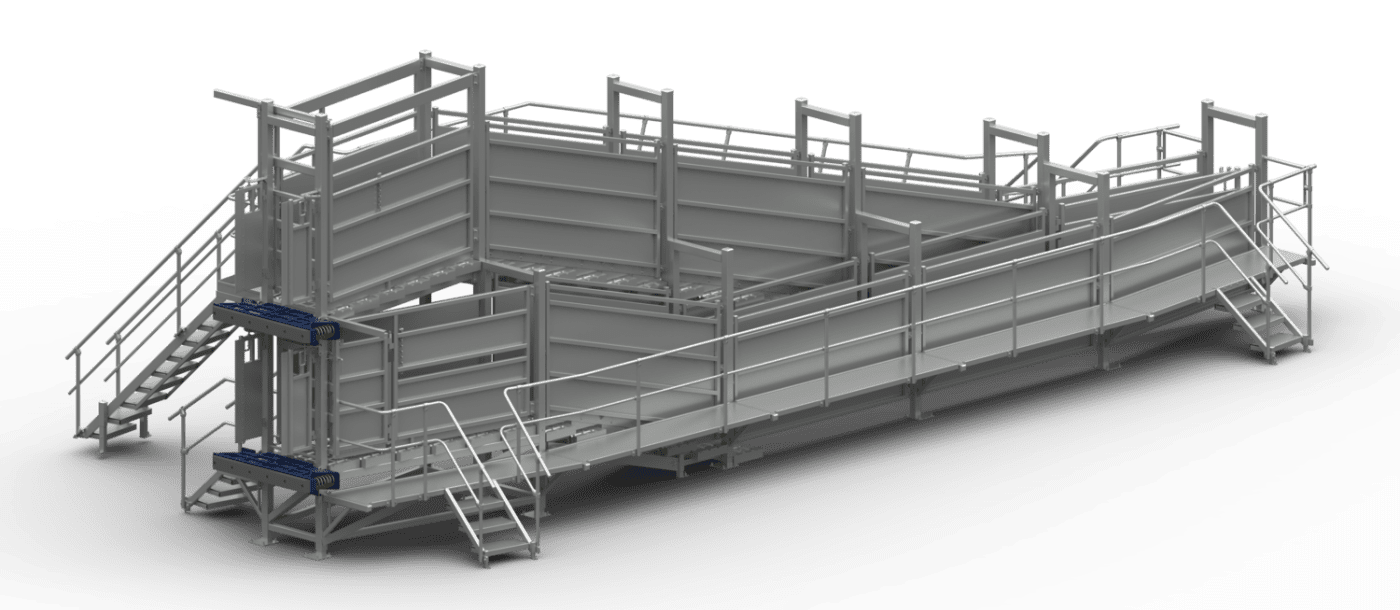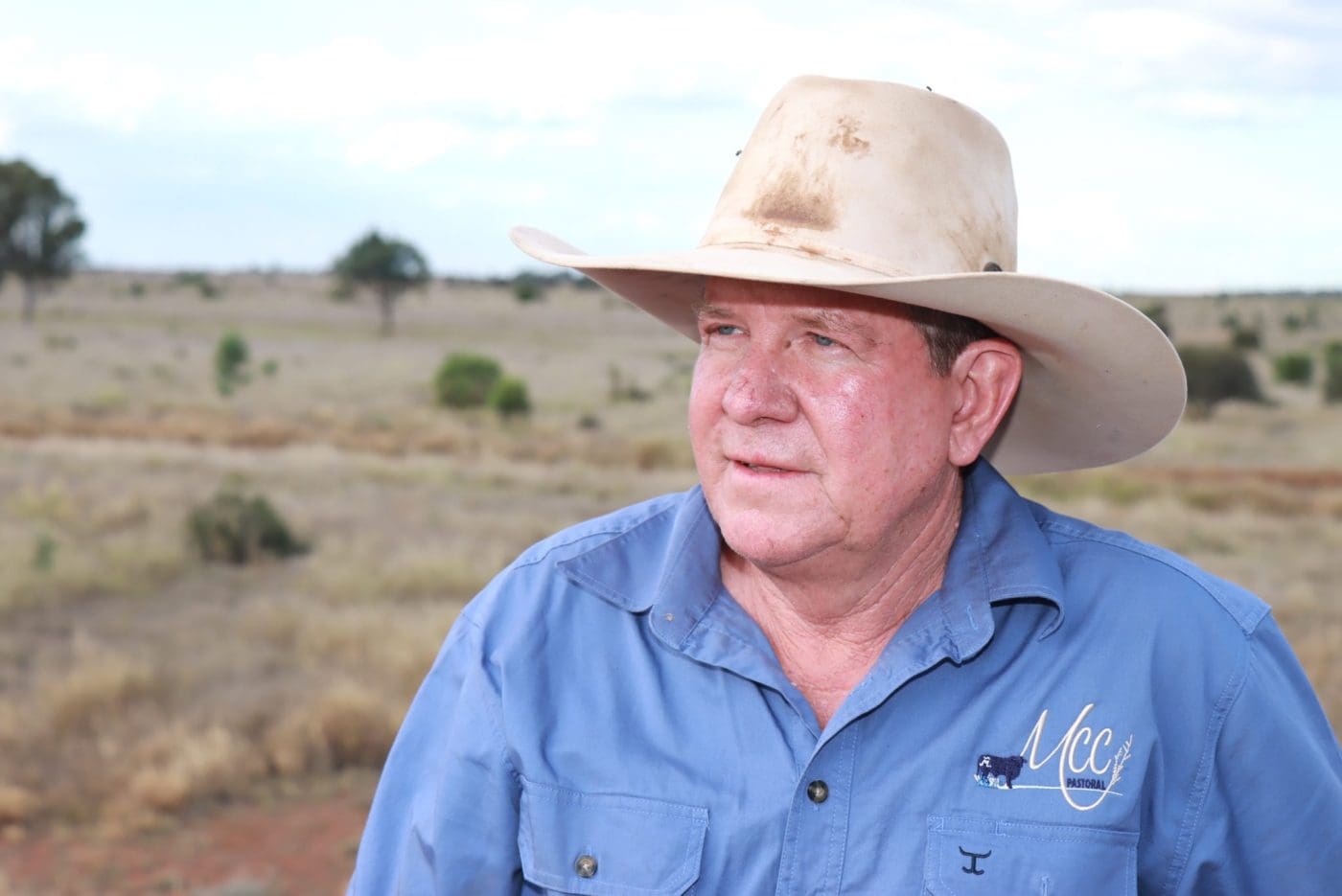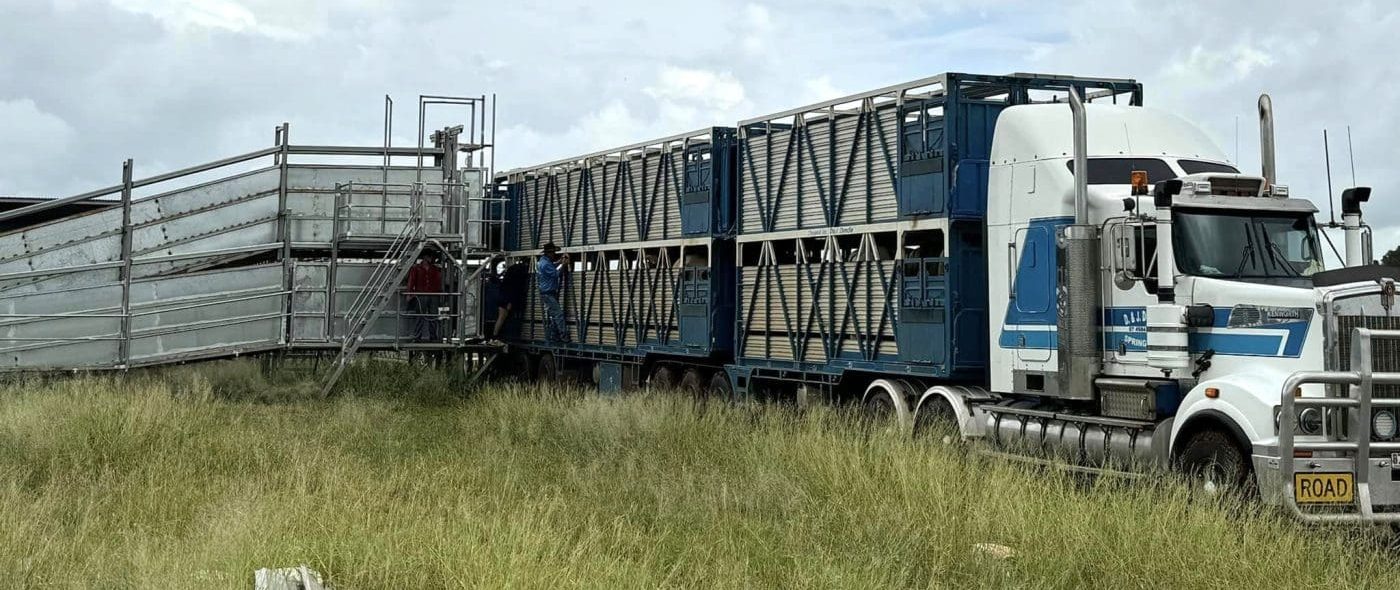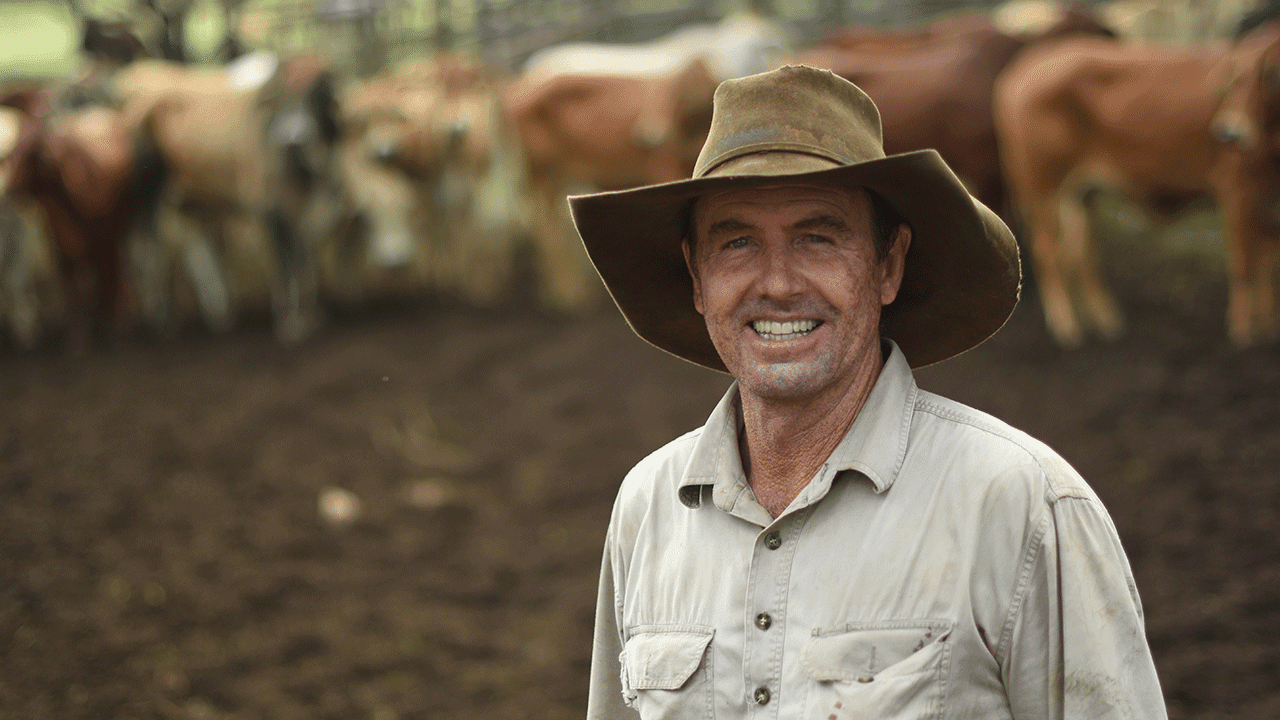This is the first in a series of articles looking at emerging trends and issues identified as part of our Top 25 Stock Transporters feature.
ONE of the observations made by operators appearing in Beef Central’s Top 25 Livestock Transporters feature this week is the growing number of double-deck loading ramps now installed on cattle properties across the country.
Improving loading efficiency and time, reducing stress and bruising on stock and heightening operator safety appear to be the key reasons.

Typical double-deck, dual race ramp design
While double-deck, dual-lane ramps are commonplace at saleyards, feedlots and processing facilities, there’s also growing evidence of them on properties, Gracemere Livestock Transport’s Alister Clarke said.
“Excluding smaller holdings, I’d estimate that 35-40 percent of the properties we visit in the Central Queensland region now have double-deck ramps,” Mr Clarke said.
“We’d like it if there was a lot more. It saves on loading time – maybe half an hour per truck – but the cattle load a lot more comfortably and with less effort. As an improvement, double-deck ramps are brilliant.”
Larger corporates and pastoral company cattle operators had also invested heavily in double-deck ramps, for safety as well as productivity and efficiency reasons, Mr Clarke said.
‘No brainer’
Central Queensland cattleman Ian McCamley has also seen a lot of growth in installations of double-deck loading ramps on cattle properties in his region.
Mr McCamley and wife Kate’s Lowesby Station near Rolleston turns over large numbers of cattle each year, principally based around trading and backgrounding young cattle for feedlot placement, as well as producing some Certified Grassfed ox. Given the high stock turnover, efficient loading and unloading is essential.
“We have a good double-deck ramp on both of our places – both Temple Grandin designs,” he said.
“The first went in about 18 years ago, when there weren’t so many around. And we’re actually even considering putting another double-deck ramp in on some country we lease,” he said.

Ian McCamley, Lowesby, Rolleston.
Double-deck ramps provided a range of advantages, saving perhaps ten minutes per trailer by not having to set up the internal ramp, and run cattle up top from the lower level.
“But more importantly, its about operator safety, and the cattle load so much better, with less stress,” Mr McCamley said.
“Cattle aren’t slipping and sliding up a steep internal trailer ramp. If it’s a good set-up, a double deck ramp should have steps on the ramp to the upper deck, rather than a continuous slope, and a moderate incline. A cloven-hooved animal naturally wants to stand on something flat.
“On the bottom deck, a flat surface rather than steps is fine, because the access slope is much shallower.”
“They (double deck ramps) are gold here, in so many ways. Sometimes we might have a situation where we have already loaded ten decks of feeders on one property, and a road train can call in and pick up the remaining two more decks on the way – running them straight onto the upper deck,” he said.
“Using a single-deck ramp means when loading bullocks at 22 to the deck, you have to squeeze them up the front of the upper deck before you can lift the ramp up. That’s all unnecessary stress, and the cattle arrive at the processing plant better having been loaded using a double-deck ramp.”

In his area, Mr McCamley estimated that somewhere between 25pc and 40pc of properties now had a double-deck ramp at the yards.
“It’s not that expensive, in real terms, especially when you consider that a place that might have been worth $10 million a decade ago might be now pushing $30 million in value. On that basis, the outlay on a double-deck ramp (somewhere between $60,000 and $80,000 for better quality stand-alone units, one manufacturer told Beef Central) is pretty minimal.”
“It’s a no-brainer,” Mr McCamley said. “It’s one of those assets that cost a lot of money when you put it in, but very quickly you completely forget about the cost, once the benefit start to flow.”
Beef Central posed a question: For a supply chain that knew it had access to double-deck ramps at either end (backgrounding property and feedlot, for example) couldn’t the transport operator order new double-deck trailers built without an internal ramp, to save on cost and weight?
“You could do it, but you’d always have to be aware of what could happen if there was a problem, and cattle had to be unloaded unexpectedly somewhere that only had a single-deck ramp,” was Mr McCamley’s response.
Taking double deck ramps to another level
North Queensland beef producer and Meat & Livestock Australia board member Russell Lethbridge is taking the double-deck loading ramp to a new level, currently installing a new dual-purpose unloading and loading facility that is about 1.7m in width. The ramp is the same width as both doors of a trailer, and cattle can walk in side-by-side and turn around when loading.

The Lethbridge family’s dedicated dual purpose loading and unloading facility on Amber Station, which acts like a series of small yards that cattle move up as they are going into the truck.
Mr Lethbridge told Beef Central the loading facility was similar to a set-up at the Blackall Saleyards.
“We talked to multiple operators about loading ramps and it was a common theme that the best place to load and unload cattle was Blackall,” he said.
“So, we went and had a look, came back and developed a similar model for our operation. It is a paradigm shift to get your head around, but 1000 truck drivers can’t be wrong about Blackall.”

Russell Lethbridge
The loading and unloading facility being finalised on the Lethbridges’ Central Queensland property, Amber, will be in a separate part of the yards to the single-file race and vet crush. Mr Lethbridge said it will operate more like a set of yards that can move through half a deck of cattle at a time.
“Cattle are more comfortable going up this than they are in a single-file race, because they are happy to travel up together, rather than being isolated in single file,” he said.
“Rather than thinking of it as a ramp, it is more a like a series of pens that they keep moving up, like they do when they are moving through cross-loading stock trailers. You do need to have a ramp that is long enough to accommodate for that.
“It is a big investment, but these things will be here for 100 years.”
The Lethbridge family has several properties in North and Central Qld, which load and unload a lot of cattle each week.
As an MLA board member, Mr Lethbridge has been big supporter of the organisation’s new Transport Hub, which aims to bring the transport and production sectors together to solve common issues.
He said good loading ramps can solve a lot of issues.
“Number one is workplace health and safety around that area, it is high and people can fall,” he said.
“When you have truck drivers come, they are new to your surrounds and you are responsible for them as well. It is about getting the job done more efficiently, with better animal welfare outcomes. We are just trying to make life better for the truck drivers and the animals.”
- Beef Central will have more on the Lethbridge family’s loading yards and work being done by MLA to support transport facilities.

Brilliant to see Blackall sale yard and the Lethbridge family challenging industry practice with their dramatic design changes that could substantially improve efficacy and safety of ramps, as well as achieve major advances in the welfare of the livestock. The new design features appear to also vastly improve the handlers’ experience, because the changes support the preferred behaviour of livestock, unlike traditional ramps.
This innovation is not new. Sir Graham McCamley built a ramp with a 1115 mm inside width and found it very efficient, as published in 1972 in the Queensland Agricultural Journal.
Loading ramp guidelines globally, including Australia, only state they should prevent stress and injury. Several well-known consultants have published personal design recommendations for livestock ramps. However, this is all unsubstantiated opinion as no rigorous testing of many paradigms that may exist within such standards has ever occurred. In contrast, there was behaviour research as long as 30 years ago on loading sheep and deer that resulted in those industries shifting to wide ramps for loading.
Sounds like a worthy topic for some industry research, Geoff. Editor